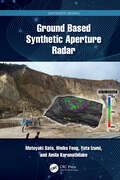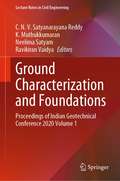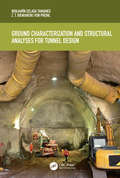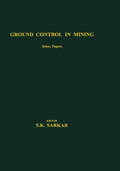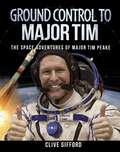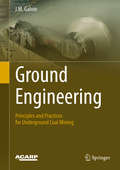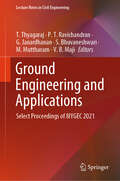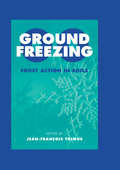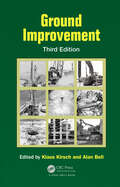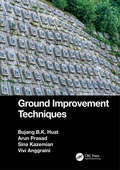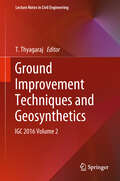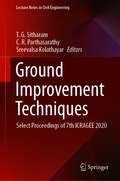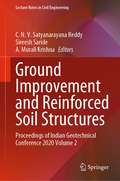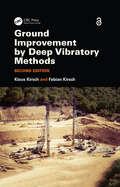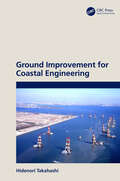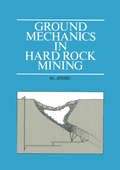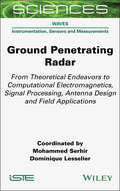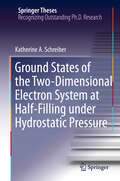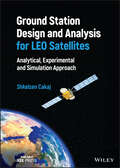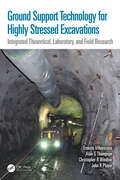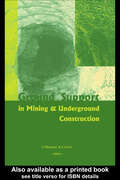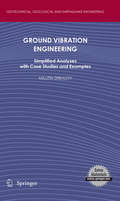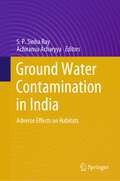- Table View
- List View
Ground Based Synthetic Aperture Radar (SAR Remote Sensing)
by Motoyuki Sato Yuta Izumi Weike Feng Amila KarunathilakeGround based synthetic aperture radar (GB-SAR) is used to effectively mitigate natural disasters and monitor social infrastructure such as bridges, dams, and airport pavement surfaces. This book explains the fundamentals of radar technology, the principles of synthetic aperture radar (SAR) image generation, and interferometric SAR (InSAR) processing for observing small ground surface deformation less than 1 mm. More advanced multiple-input multiple-output (MIMO) radar for ground surface observation is introduced. The authors also provide examples of GB-SAR used for monitoring landslide and vegetation to show its potential and limitations. Understanding this advanced technology and its applications will help readers plan and install GB-SAR systems in real-life projects.Features: Introduces GB-SAR, an advanced tool that measures in-millimeter ground surface displacement. Explains how the GB-SAR system can be installed for landslide monitoring. Provides a new radar technology that monitors vibrations of infrastructure remotely. Discusses the advanced radar technology related to polarimetry and interferometry. Includes several case studies applying the tools and techniques discussed to natural disasters, such as landslides, volcanoes, glaciers, and so on. This book is intended for civil professionals who deal with disaster mitigation and infrastructure monitoring and those in electrical engineering, including radar technology. It is also an excellent resource for upper-level undergraduate and graduate students taking courses in remote sensing and photogrammetry, geography, geodesy, information science, engineering, and geology, as well as researchers and scientists interested in learning the techniques and technologies for collecting, analyzing, managing, and visualizing geospatial data sets.
Ground Characterization and Foundations: Proceedings of Indian Geotechnical Conference 2020 Volume 1 (Lecture Notes in Civil Engineering #167)
by C. N. V. Satyanarayana Reddy K. Muthukkumaran Neelima Satyam Ravikiran VaidyaThis book comprises the select proceedings of the Indian Geotechnical Conference (IGC) 2020. The contents focus on recent developments in geotechnical engineering for a sustainable tomorrow. The book covers the topics related to traditional and latest methods in characterisation of ground at construction sites, recent technological developments/ advances in design of shallow and deep foundations in different subsoil conditions.
Ground Characterization and Structural Analyses for Tunnel Design
by Benjamín Celada Z.T. BieniawskiThis practical and design-oriented book focuses on ground characterization and structural calculation, as part of the active structural design methodology. With a focus on rock tunnelling it offers a comprehensive rather than a topic-based perspective, deriving sound tunnel design criteria and methods from basic principles. Ground characterization includes excavations, site investigation, and in situ stress determination, culminating in geotechnical classifications. The book then deals with various construction methods and their appropriate calculations, which range from constitutive models for the stress-strain behaviour of an excavation and tunnel support elements to a full stress–strain analysis methodology. The heavily practical approach of the book draws on the authors’ twenty years of tunnelling experience in Spain and South America. It will help any young or established professional who wants to develop a career in the underground field across both civil engineering and geology. As it incorporates the very fundamentals of tunneling design, it can be used as a support for tunneling courses or as a textbook for master’s and PhD courses. Benjamín Celada was Chief Tunnel Engineer at Hunosa and Potasas de Navarra S.A. before founding Geocontrol S.A. He has also worked for twenty years as Professor of Underground Works at the Polytechnic Mining University in Madrid, Spain. Z. T. Bieniawski directed the Rock Mechanics Department of the Council for Scientific and Industrial Research in Pretoria, then taught at the Pennsylvania State University for twenty years.
Ground Control in Mining
by S.K. SarkarCovering the subject of ground control in mining, this volume looks at such topics as: rock-slab theory of ground pressure in work and practice, the role of in situ-stress in mine planning, and the status of the art of cable bolting.
Ground Control to Major Tim: The Space Adventures of Major Tim Peake
by Clive GiffordAimed at children inspired by Major Tim Peake's adventures in space, this 32-page book looks at the history-making career of the man who, in 2016, became the first British astronaut to live and work on the International Space Station. During his time on board the ISS, Tim Peake carried out experiments, performed a crucial spacewalk and took some awesome photographs. He also found time to run a marathon, present an award to Adele and read a bedtime story to children listening 400km below him on Earth. Packed with amazing photographs, this book reveals how Major Tim's fascination with flight and science began and how his career as an astronaut developed, documenting his inspirational journey into space.
Ground Engineering - Principles and Practices for Underground Coal Mining
by J. M. GalvinThis book teaches readers ground engineering principles and related mining and risk management practices associated with underground coal mining. It establishes the basic elements of risk management and the fundamental principles of ground behaviour and then applies these to the essential building blocks of any underground coal mining system, comprising excavations, pillars, and interactions between workings. Readers will also learn about types of ground support and reinforcement systems and their operating mechanisms. These elements provide the platform whereby the principles can be applied to mining practice and risk management, directed primarily to bord and pillar mining, pillar extraction, longwall mining, sub-surface and surface subsidence, and operational hazards. The text concludes by presenting the framework of risk-based ground control management systems for achieving safe workplaces and efficient mining operations. In addition, a comprehensive reference list provides additional sources of information on the subject. Throughout, a large variety of examples show good and bad mining situations in order to demonstrate the application, or absence, of the established principles in practice. Written by an expert in underground coal mining and risk management, this book will help students and practitioners gain a deep understanding of the basic principles behind designing and conducting mining operations that are safe, efficient, and economically viable. Provides a comprehensive coverage of ground engineering principles within a risk management framework Features a large variety of examples that show good and poor mining situations in order to demonstrate the application of the established principles in practice Ideal for students and practitioners About the author Emeritus Professor Jim Galvin has a relatively unique combination of industrial, research and academic experience in the mining industry that spans specialist research and applied knowledge in ground engineering, mine management and risk management. His career encompasses directing ground engineering research groups in South Africa and Australia; practical mining experience, including active participation in the mines rescue service and responsibility for the design, operation, and management of large underground coal mines and for the consequences of loss of ground control as a mine manager; appointments as Professor and Head of the School of Mining Engineering at the University of New South Wales; and safety advisor to a number of Boards of Directors of organisations associated with mining.
Ground Engineering and Applications: Select Proceedings of 8IYGEC 2021 (Lecture Notes in Civil Engineering #429)
by V. B. Maji M. Muttharam T. Thyagaraj P. T. Ravichandran G. Janardhanan S. BhuvaneshwariThis volume presents the select proceedings of the 8th Indian Young Geotechnical Engineers Conference (8IYGEC 2021) on the following conference themes: Ground Improvement and Transportation Geotechnics. The papers in this volume cover a wide range of topics on ground improvement which include the modification using different synthetic and natural materials and inclusions in the form of fibers, geotextiles, geogrids, prefabricated vertical drains and soil nails in different ground improvement applications, and chemical modification of problematic soils using both natural additives and industrial by-products such as lime, cement, calcium chloride, calcium carbide, lignosulphonate, fly ash, blast furnace slag and bioenzymes, treatment of expansive soils with granular piles, vibro-compaction, etc. Further, this volume covers the various aspects of transportation geotechnics related to the static and dynamic performance of pavements reinforced with geosynthetic materials, drainage characteristics, and the use of marginal materials in pavements, etc. The book can be a valuable reference for researchers and professionals.
Ground Freezing 2000 - Frost Action in Soils
by Jean-François ThimusThere has been increasing interest in the use of Artificial Ground Freezing (AGF) in forming efficient barriers to prevent pollution penetrating geological deposits. This volume includes papers on heat and mass transfer, frost susceptibility and frost heave, and mechanical properties.
Ground Improvement
by Alan Bell Klaus KirschWhen finding another location, redesigning a structure, or removing troublesome ground at a project site are not practical options, prevailing ground conditions must be addressed. Improving the ground modifying its existing physical properties to enable effective, economic, and safe construction to achieve appropriate engineering performance is an
Ground Improvement Techniques
by Bujang B.K. Huat Arun Prasad Sina Kazemian Vivi AnggrainiThis book provides a review of problems during design and construction on problematic soils. Design methods, site investigation, construction and analysis of the various improvement methods available are explained and discussed. Various regions may have different soils with geotechnical problems that differ from those faced in other regions. For example, in Southeast Asia, the common geotechnical problems are those associated with construction on soft clays and organic soils, while in the arid region of the Middle East, problems are generally associated with the desert soils. In the US, the problems are associated with organic soils, expansive and collapsing soils, and shale. Laterite and lateritic soils are especially problematic in Mexico. Similarly, in Europe, for example, the geotechnical problems are associated with loess (France), and organic soil (Germany). A detailed description of various methods of ground improvement has been provided in 11 chapters. Each chapter deals not only with a description of the method but also focuses on region-specific ground problems and suitable ground improvement techniques. Case studies have also been included. One general chapter is dedicated to site investigation, instrumentation, assessment and control. This book will be of value to students and professionals in the fields of civil and geotechnical engineering, as well as to soil scientists and engineering geologists.
Ground Improvement Techniques and Geosynthetics: Igc 2016 Volume 2 (Lecture Notes in Civil Engineering #14)
by T ThyagarajThe book comprises select proceedings of the 2016 annual conference of the Indian Geotechnical Society (IGC 2016), with technical papers on the theme “Ground Improvement and Geosynthetics”. The papers cover a wide range of topics, including chemical modification using admixtures, microbial-induced carbonate precipitation, geopolymers, fly ash and other industrial wastes, modification using geosynthetic materials such as natural and synthetic fibers, expanded polystyrene (EPS) geofoam, prefabricated vertical drains, geosynthetic encased-granular columns and mechanical densification through sand columns. This book is a valuable reference for researchers and practicing engineers alike.
Ground Improvement Techniques: Proceedings of the Indian Geotechnical Conference 2021 Volume 3 (Lecture Notes in Civil Engineering #297)
by Arif Ali Baig Moghal Kasinathan Muthukkumaran Rajesh Sathiyamoorthy S. P. JeyapriyaThis book comprises the select peer-reviewed proceedings of the Indian Geotechnical Conference (IGC) 2021. The contents focus on Geotechnics for Infrastructure Development and Innovative Applications. The book covers topics related to ground improvement techniques, like stone columns, PVD, granular pile anchors, soil stabilization methods, like fly ash & chemicals, effect of biopolymer inclusion, innovative material for soil and ground improvement, among others. This volume will be of interest to those in academia and industry.
Ground Improvement Techniques: Select Proceedings of 7th ICRAGEE 2020 (Lecture Notes in Civil Engineering #118)
by T. G. Sitharam Sreevalsa Kolathayar C. R. ParthasarathyThis volume presents select papers presented at the 7th International Conference on Recent Advances in Geotechnical Earthquake Engineering and Soil Dynamics. The papers discuss advances in the fields of soil dynamics and geotechnical earthquake engineering. Some of the themes include slope stability, shallow and deep foundations, geosynthetics, ground improvement techniques, etc. A strong emphasis is placed on connecting academic research and field practice, with many examples, case studies, best practices, and discussions on performance based design. This volume will be of interest to researchers and practicing engineers alike.
Ground Improvement and Reinforced Soil Structures: Proceedings of Indian Geotechnical Conference 2020 Volume 2 (Lecture Notes in Civil Engineering #152)
by Sireesh Saride A. Murali Krishna C. N. V. Satyanarayana ReddyThis volume comprises the select proceedings of the Indian Geotechnical Conference (IGC) 2020. The contents focus on recent developments in geotechnical engineering for sustainable tomorrow. The volume covers the topics related advances in ground improvement of weak foundation soils for various civil engineering projects and design/construction of reinforced soil structures with different fill materials using synthetic and natural reinforcements in different forms.
Ground Improvement by Deep Vibratory Methods
by Klaus Kirsch Fabian KirschVibro compaction and vibro stone columns are the two dynamic methods of soil improvement most commonly used worldwide. These methods have been developed over almost eighty years and are now of unrivalled importance as modern foundation measures. Vibro compaction works on granular soils by densification, and vibro stone columns are used to displace and reinforce fine-grained and cohesive soils by introducing inert material. This second edition includes also a chapter on vibro concrete columns constructed with almost identical depth vibrators. These small diameter concrete piles are increasingly used as ground improvement methods for moderately loaded large spread foundations, although the original soil characteristics are only marginally improved. This practical guide for professional geotechnical engineers and graduate students systematically covers the theoretical basis and design principles behind the methods, the equipment used during their execution, and state of the art procedures for quality assurance and data acquisition. All the chapters are updated in line with recent developments and improvements in the methods and equipment. Fresh case studies from around the world illustrate the wide range of possible applications. The book concludes with variations to methods, evaluates the economic and environmental benefits of the methods, and gives contractual guidance. The Open Access version of this book, available at http://www.taylorfrancis.com, has been made available under a Creative Commons Attribution-Non Commercial-No Derivatives 4.0 license
Ground Improvement for Coastal Engineering
by Hidenori TakahashiThis practical guide covers the investigation, design, and execution of ground improvement in coastal areas. It explains how to decide whether ground improvement is necessary, which method to choose, and how to design and execute it. Recognising the soft ground commonly found in coastal areas, the book introduces various ground improvement technologies including seismic reinforcement and liquefaction countermeasures and addresses the measures to be taken to sustain ground against external forces. Reliable Japanese ground improvement technologies are presented as well as the latest Building Information Modelling (BIM/Information and Communication Technology (ICT) used in their execution. The book also includes measures that can be taken against contaminated soil and considers ground improvement design on site. Unique focus on coastal applications Summarises leading edge Japanese practice The book suits professionals in the ground improvement industry, especially geotechnical designers and contractors.
Ground Mechanics in Hard Rock Mining
by M.L. JeremicThis book illustrates the advantages of the application of ground mechanic concepts to hard rock mining. It examines the ground stability for various mine layouts using specific case histories. The book deals with ground support, reinforcement, and stabilization of mining structures.
Ground Penetrating Radar: From Theoretical Endeavors to Computational Electromagnetics, Signal Processing, Antenna Design and Field Applications
by Dominique Lesselier Mohammed SerhirThis book offers an overview of modern advances in Ground Penetrating Radar (GPR) for the reader hoping to understand comprehensive electromagnetic culture, combining instrumental development of radar, signal processing, imaging, and calibration/correction of measured data. GPR has a multi-disciplinary character that can bring together a diverse and broad community. Of concern are the design and optimization of innovative radars, by virtue of the antennas and associated electronics, imaging algorithms, methodological diversity, calibration procedures, and the development of tools for the interpretation of data in mono-static or multi-static configurations within frequency or transient domains. This book provides illustrations in civil engineering for the diagnosis of transport infrastructures and buildings, archeological surveys for the appreciation of cultural heritage, detection of underground pipes and cavities, estimation of soil water content for agriculture, and mapping of root trees developing underground, and in planetology, the analysis of the internal structure of planets and other celestial bodies through electromagnetic waves.
Ground States of the Two-Dimensional Electron System at Half-Filling under Hydrostatic Pressure (Springer Theses)
by Katherine A. SchreiberThis thesis presents the discovery of a surprising phase transition between a topological and a broken symmetry phase. Phase transitions between broken symmetry phases involve a change in symmetry and those between topological phases require a change in topological order; in rare cases, however, transitions may occur between these two broad classes of phases in which the vanishing of the topological order is accompanied by the emergence of a broken symmetry. This thesis describes observations of such a special phase transition in the two-dimensional electron gas confined in the GaAs/AlGaAs structures. When tuned by hydrostatic pressure, the ν = 5/2 and ν = 7/2 fractional quantum Hall states, believed to be prototypical non-Abelian topological phases of the Pfaffian universality class, give way to an electronic nematic phase. Remarkably, the fractional quantum Hall states involved are due to pairing of emergent particles called composite fermions. The findings reported here, therefore, provide an interesting example of competition of pairing and nematicity. This thesis provides an introduction to quantum Hall physics of the two-dimensional electron gas, contains details of the high pressure experiments, and offers a discussion of the ramifications and of the origins of the newly reported phase transition.
Ground Station Design and Analysis for LEO Satellites: Analytical, Experimental and Simulation Approach
by Shkelzen CakajTutorial for analytical and scientific approaches related to LEO satellites ground station performance, including math, experiments, and simulations. Ground Station Design and Analysis for LEO satellites provides complete instructions and steps for ground station performance evaluation, including stations dedicated for scientific or communication purposes, and offers the reader an enhanced learning experience by proposing 40 ideas related to ground station performance assessment. Each idea goes over the math analysis, experiment or simulation, the methodology applied, the results, and a conclusion. This approach provides the reader with the opportunity to compare theoretical results with on-site results, guiding the reader towards intelligent and practical performance evaluation and enhancement. The text also considers the future emerging developments of LEO satellites and their challenges and applications, including multimedia and other scientific applications. Stemming from the highly qualified author&’s research work of roughly 20 years, Ground Station Design and Analysis for LEO Satellites includes information on: Interference aspects, covering intermodulation interference modeling for LEO satellite ground stations and downlink adjacent interference for LEO search and rescue satellites Sun synchronization, covering nodal regression and Sun synchronization of low Earth orbits through inclination angle. Horizon plane and communication duration, covering communications duration with LEO satellites under ideal, practical and designed horizon plane for LEO satellite ground stations Figure of merit and system noise temperature, covering composite and antenna noise temperature, Sun noise experiment and desensibilization measurements at LEO satellite ground stations Ground Station Design and Analysis for LEO Satellites is an innovative and advanced tutorial-based resource that will appeal to satellite engineers (operators/vendors) working on the operation, maintenance, and performance evaluation of ground stations, as well as postgraduate students/early-stage researchers wishing to obtain knowledge on this state-of-the-art technology.
Ground Support Technology for Highly Stressed Excavations: Integrated Theoretical, Laboratory, and Field Research
by Ernesto Villaescusa Alan G Thompson Christopher R Windsor John R PlayerThe performance of ground support as a scheme is essential to constrain failures occurring at the rock surfaces of deep or highly stressed excavations. This book covers laboratory and theoretical developments coupled with field experiments and observations with the implementation of the methodology at mines. It explains the energy dissipation capabilities of reinforcement and support systems leading to the design of complete ground support schemes that can maintain integrity following the dynamic ejection of a mass of rock from an excavation boundary. The key features of the book are as follows It explores the mechanics, demand and capacity of ground support technology. It covers the whole gamut of theories, laboratory and field test results and case studies related to ground support technology. It includes a comprehensive database of mesh, rock bolts, cable bolts and shotcrete capacity. It examines ground support scheme testing and explanation. It discusses comprehensive case studies, including de-stress blasting. This book is aimed at professionals in mining engineering, including civil engineering, geological engineering and geotechnical engineering, and related advanced postgraduate studies.
Ground Support in Mining and Underground Construction: Proceedings of the Fifth International Symposium on Ground Support, Perth, Australia, 28-30 September 2004
by Ernesto Villaescusa Yves PotvinThe purpose of ground support is to safely maintain excavations for their expected lifespan. The effectiveness of ground support can be seen both in terms of personnel and equipment safety, and in terms of allowing the most economic extraction. Scientists, practitioners and technology developers have contributed to this volume, which covers rock ma
Ground Vibration Engineering
by Milutin SrbulovGround vibration consideration is gaining significance with people's decreasing tolerance of vibration, introduction of new environmental legislations, increasing use of equipment sensitive to vibration, ageing of existing buildings and expanding construction sites to/near collapsible/liquefiable/thixotropic soil. This volume bridges the gap that exists between rather limited provisions of engineering codes/standards and complex numerical analyses/small-scale tests. The book contains descriptions of ground vibration measurements, predictions and control for engineers. Effects of most frequent sources of ground vibration arising from construction/demolition, traffic and machinery, ground wave amplification and attenuation as well as foundation kinematic and inertial interaction have been considered by simplified analyses aimed at ease and speed of use for major problems in ground vibration engineering. Comments on assumptions, limitations, and factors affecting the results are given. Case studies and examples worldwide are included to illustrate the accuracy and usefulness of simplified methods. A list of references is provided for further consideration, if desired. Audience: This work is of interest to geotechnical engineers, engineering geologists, earthquake engineers and students. Extra material: Microsoft Excel spreadsheets with the input data and results for the case studies and examples considered in this book are available at http://extras.springer.com
Ground Water Contamination in India: Adverse Effects on Habitats
by Achiransu Acharyya S. P. Sinha RayThis book examines contamination in groundwater. Groundwater is a lifeline for most countries of the world. 90% of the Indian population rely on groundwater-based drinking water as safe mode of water supply. The terminology contamination in groundwater along with adverse effect on habitats, suggests the impact of such contamination in not only for drinking water, but also for agricultural irrigation. In addition, polluted groundwater causes adverse health hazards including social aspects that affect wider communities. Impacts on plant life also are equally threatening. This book provides readers with an insight into groundwater contamination in India. The economic loss associated with this devastating phenomenon is also studied in detail, which has a direct bearing to the country's GDP.
Ground Water Development - Issues and Sustainable Solutions
by S. P. RayGround water resources are receiving global attention, as human population growth and development cause significant changes to the earth system. It plays a major role in ensuring livelihood security in many parts of South Asia and its contribution to poverty alleviation is substantial. The complex nature of ground water problems in the Indian Sub-continent requires a precise delineation of the ground water regimes in different hydro geological settings and socio-economic conditions and is a primary necessity for sustainable and equitable management. Strategies to respond to ground water over-exploitation and deteriorating water quality must be based on a new approach. Practical policies and various solution options urgently need to be formulated and implemented to prevent the development problems. There is pressing need to evolve workable methods and approaches based on modern scientific researches on ground water resources, as well as to build a social framework including community participation at all levels for a ground water development system. The community participation in water pumping policies, incentives of efficient use, affordability of low income users and other vulnerable groups, water awareness are prime factors for success of any ground water based water supply project.
